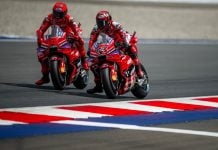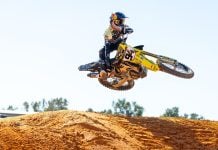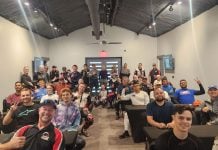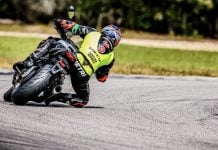Copyright 2002, Roadracing World Publishing, Inc.
Wall Moved Back In Turn Five, Track Surveillance System, Mini-ambulance; Plans For Revised Turn 11, Lighting System, Air Fence Bike
By David Swarts
Without fanfare or publicity, Road America has completed substantial safety improvements, with more in the works.
The biggest change seen during the April 25-28 CCS Regional at the Elkhart Lake, Wisconsin racetrack was a new closed-circuit TV surveillance system that offers a view of “about 95 percent” of the track from one seat in Race Control. The system was used throughout the CCS race weekend, starting with Thursday’s Team Hammer Advanced Riding School & Track Ride day.
“There are 16 cameras right now,” said George Bruggenthies, Road America President and General Manager. “We’ve positioned the cameras so that we have a continuous view of the track. Each corner has a stationary camera looking upstream and a pan/zoom/tilt-camera next to it that looks downstream. If we see something upstream, we can cover each of the areas with the moveable camera. So half of them are moveable. Actually, we have seven moveable cameras here.” There are two cameras in turn one, turn three, turn five, turn seven, the Carousel, turn 12 and turn 14; with single cameras in The Kink and on top of the control building at start/finish.
“It’s supported by a fiber-optics communications backbone that we installed last year. It (the fiber-optic network) has the capability to support a variety of other services, including a hard-line communications system with two channels (for cornerworkers).” Retail cost of the four-mile-long track’s system is about $2 million, but Bruggenthies said that through the track’s partners, the actual cost “wasn’t anywhere close to that, but it’s quite an investment. That’s why you don’t see it everywhere.”
Although there was only one crash on Thursday, the TV surveillance system was put through its paces during the remainder of the CCS race weekend when the weather turned very cold with rain, sleet and snow falling at various times.
Road America Safety Director Carson Wilkinson, working with with Race Control Director Bill Ritger, used the TV cameras to find and access on-track incidents and order the proper response by cornerworkers and track safety personnel.
The surveillance system was also used to dispatch security to handle crowd control situations and even by the CCS race staff to settle disputes in scoring and penalties.
The computerized system has the ability to record and play back, via computer hard drive, everything seen by every camera for up to 72 hours. Red flag crashes were played back to show who caused the incident, and the replays have been used as evidence to enforce disciplinary penalties.
“Our intent is to put in signal lighting at some point,” said Bruggenthies. “It would be at all of the flagging stations. We’re not trying to replace the cornerworkers. We still need the cornerworkers for communication and the eyes and ears on site, but it would provide safety for the cornerworkers rather than having them stand in harm’s way or even with their arm flagging.
“It would be a light, a multiple-colored light. So whether it was a yellow condition or a double-yellow condition or a red flag or whatever, it could be determined by lights that would be controlled here by race control by the operating steward. That’s already built into (the fiber-optic network). Plus the response, it would just help the cornerworkers a lot more. They’re out there trying to talk, holding the radio in one hand, flag in the other. This way we could take care of one of those tasks for them.
“(The fiber-optic network is) also for broadcast TV. The TV companies now have, essentially, plug-ins for their digital cameras, if they have digital cameras. So you can do HDTV broadcasts. Instead of dragging 8000 miles of cable here, you can just plug in. It also supports the P.A. system that goes around the facility. It’s got a lot of other capabilities that we’re still exploring.
“Nobody really sees that,” pointed out Bruggenthies, when asked about the way the track has quietly improved safety. “We’re constantly doing safety improvements. Here at (turn) five, we’ve provided some (extra) run-off. The wall (on riders’ right) used to be much closer to the track, and if you fell off the track here, a heavy passing zone, you’d be in the barrier. Now we’ve put in an asphalt recovering zone that you can recover and continue. It added a lot of safety that way.
“The wall was moved back considerably (a gradual improvement from the original wall to 40 feet further back), and it actually provides better spectating for the spectators (in the turn five grandstands). Now they can see over the barrier. It’s improved the viewing for the spectators and it’s improved safety for the riders and drivers. We’re doing stuff all the time.”
During the CCS race weekend, at least two racers lost the front end early in the braking zone for turn five and slid through the area where the old wall had been. Both racers still brushed the new wall at shallow angles, but both got up and walked away. Only one racer was transported to a local hospital all weekend, and that rider was released after 24 hours of observation for abdominal pain.
Another Road America safety improvement was the addition of a $30,000 “mini-ambulance”, built on to a modified Club Car golf cart chassis. “It’s a highly-mobile BLS (Basic Life Support),” said Bruggenthies. “So it has the same capability as an ambulance, but an ambulance weighs about 9000 pounds and has big dual wheels.”
According to Safety Director Wilkinson, the gas-engine-powered mini-ambulance’s chassis features raised ground clearance, increased suspension travel, aggressive all-terrain tires and a locking rear differential. “They (conventional ambulances) can’t get in a lot of areas,” added Bruggenthies. “This mobile ambulance is much more ambulatory. It can go up hills and get to the more rural parts of the facility or you can station it, right now we have it stationed at (turn) 11 (The Kink) and it can actually reach a potential patient right on the grass (without getting on the track surface). We can respond to an incident and do it in a safer manner that allows better safety for the continuing riders or drivers. We couldn’t do that with an ambulance. Plus you can get behind the barriers. It really makes sense for our terrain here.
“We’re constantly improving as we can afford things. We’re going to be adding a different configuration to turn 11 (The Kink) at some point in the future. Not taking away the existing configuration, but putting an option that would, essentially, make a left turn (before The Kink) and provide a chicane for 11. Some of the smaller club events, that turn’s a bit much for them. So we’re trying to provide an alternative road course for them at that point.
“They would turn left before The Kink and put a chicane in that would provide a straight entry for that. They would also have lost a lot of speed at that point with the chicane. So it would reduce their speed coming into (turn) 12. It would provide run-off, where as right now (The Kink is) a very tight, blind right turn. It’s a high-speed turn. CHAMP (CART) cars go through there at 190 mph, and I don’t know what the bikes are doing today. 130? 140?.
“Hopefully by next year, we’ll have Air Fence Bike product. We’re looking for sponsorship for the product right now. It’s an expensive product. I don’t think there’s any price for safety, but I think we’re a fairly safe course right now. We’ve got a lot of Air Fence out there and the haybales, but we would like to put more friendly products that don’t require quite the maintenance than these products that we’re currently using. The Air Fence, you’ve got to blow it up and some times it moves and some things like that. It works very well, but some time there’s a bit of down time when you have to repair or replace it. This other product would help us better stay on schedule.”
When asked why Road America, one of America’s premier road courses and the host of high-level auto racing events, like CART, would make pro-active safety improvements for motorcycles, Bruggenthies revealed, “I’m an avid motorcyclist myself. I was down at Bike Week. I just came back from a trip to Asheville, North Carolina, an eight-day trip where I put 2100 miles on my Ninja ZX-11 (equipped with hard saddlebags and a trunk). I enjoy it. It’s very athletic. It’s good for me.
“Deal’s Gap, Smokey Mountains, Blue Ridge Mountains, the Blue Ridge Mountain Parkway, I went up to Hot Springs and found some good roads along the way, 63 North of Asheville. I found a good map and a lot of good advice from guys who had been down there and just had a great time. I just went down there for the ride and the roads.”
Bruggenthies added that he owns two vintage Hondas and a Yamaha FZ600, in addition to his Ninja. Got your eye on any new bikes, George? “Well, Suzuki is our official motorcycle here. So I get the use of a nice Suzuki. Last year, we had a 750 GSX-R. This year I think they have a 600 model that’s a F1 replica or something. Yeah, we’re getting a Telefonica Movistar Suzuki Kenny Roberts replica. They’re a lot of fun. Sometimes, I pace the races with them.”
Road America Makes Safety Improvements
Road America Makes Safety Improvements
© 2002, Roadracing World Publishing, Inc.






